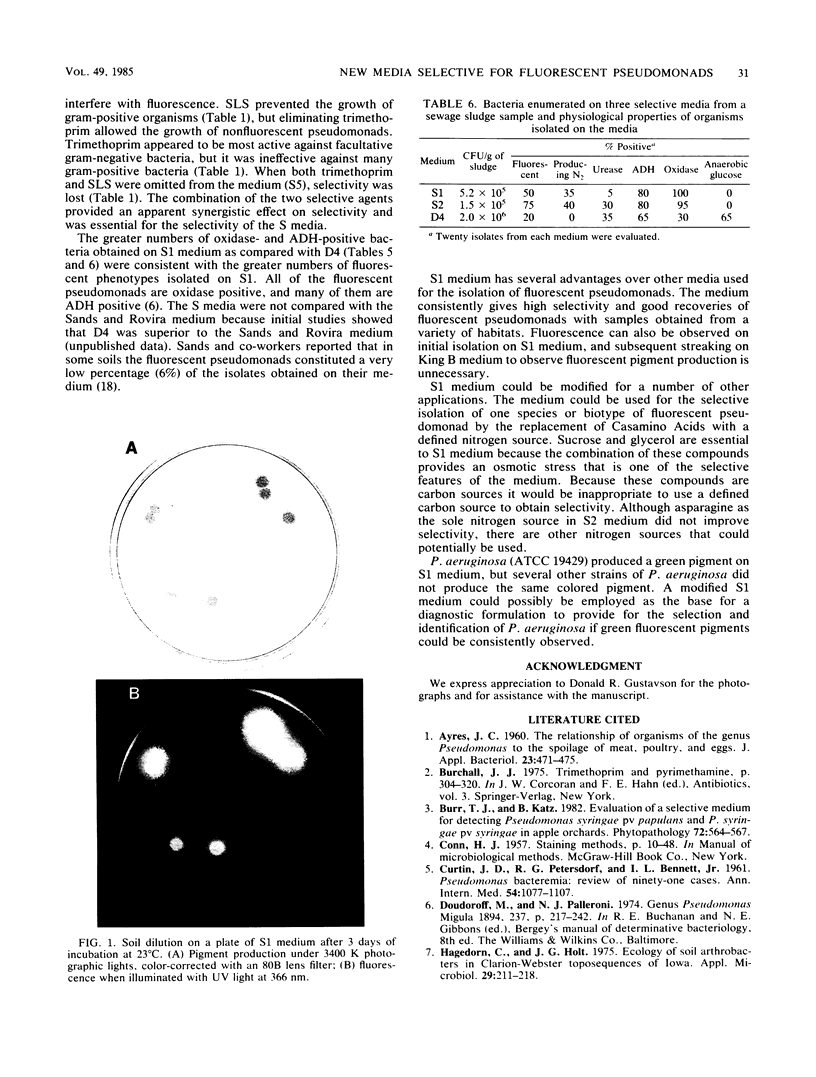Abstract
New media (S1 and S2) were formulated that provide a high degree of selectivity and detection of fluorescent pseudomonads on initial plating. The selectivity of the S-type media was based on a detergent, sodium lauroyl sarcosine, and an antibiotic, trimethoprim. A total of five soils from different geographical locations and one sewage sludge sample were examined. On S1 medium, isolates from two soils with low fluorescent pseudomonad populations exhibited a high frequency of arginine dihydrolase (78%) and oxidase-positive (95%) phenotypes, but no fermentative isolates were recovered. Medium S2 was more defined and selective than S1, but lower numbers of fluorescent pseudomonads were recovered on S2. In soils in which fluorescent pseudomonads represent a small proportion of the total population, S1 medium consistently recovered high percentages of fluorescent phenotypes (82.5%).
Full text
PDF




Images in this article
Selected References
These references are in PubMed. This may not be the complete list of references from this article.
- Hagedorn C., Holt J. G. Ecology of soil arthrobacters in clarion-webster toposequences of iowa. Appl Microbiol. 1975 Feb;29(2):211–218. doi: 10.1128/am.29.2.211-218.1975. [DOI] [PMC free article] [PubMed] [Google Scholar]
- KING E. O., WARD M. K., RANEY D. E. Two simple media for the demonstration of pyocyanin and fluorescin. J Lab Clin Med. 1954 Aug;44(2):301–307. [PubMed] [Google Scholar]
- Kado C. I., Heskett M. G. Selective media for isolation of Agrobacterium, Corynebacterium, Erwinia, Pseudomonas, and Xanthomonas. Phytopathology. 1970 Jun;60(6):969–976. doi: 10.1094/phyto-60-969. [DOI] [PubMed] [Google Scholar]
- Misaghi I., Grogan R. G. Nutritional and biochemical comparisons of plant-pathogenic and saprophytic fluorescent pseudomonads. Phytopathology. 1969 Oct;59(10):1436–1450. [PubMed] [Google Scholar]
- Sands D. C., Rovira A. D. Isolation of fluorescent pseudomonads with a selective medium. Appl Microbiol. 1970 Sep;20(3):513–514. doi: 10.1128/am.20.3.513-514.1970. [DOI] [PMC free article] [PubMed] [Google Scholar]
- Sands D. C., Rovira A. D. Pseudomonas fluorescens biotype G, the dominant fluorescent pseudomonad in South Australian soils and wheat rhizospheres. J Appl Bacteriol. 1971 Mar;34(1):261–275. doi: 10.1111/j.1365-2672.1971.tb02285.x. [DOI] [PubMed] [Google Scholar]



